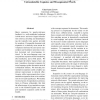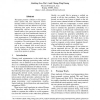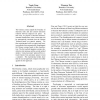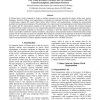168 search results - page 2 / 34 » Chinese Segmentation Disambiguation |
IRAL
2003
ACM
13 years 10 months ago
2003
ACM
Query expansion by pseudo-relevance feedback is a well-established technique in both mono- and cross- lingual information retrieval, enriching and disambiguating the typically ter...
ACL
2003
13 years 6 months ago
2003
This paper presents a Chinese word segmentation system that uses improved sourcechannel models of Chinese sentence generation. Chinese words are defined as one of the following fo...
ACL
2012
11 years 7 months ago
2012
The Chinese comma signals the boundary of discourse units and also anchors discourse relations between adjacent text spans. In this work, we propose a discourse structureoriented ...
LREC
2010
13 years 6 months ago
2010
In Chinese texts, words composed of single or multiple characters are not separated by spaces, unlike most western languages. Therefore Chinese word segmentation is considered an ...
ACL
2006
13 years 6 months ago
2006
This paper presents a new approach based on Equivalent Pseudowords (EPs) to tackle Word Sense Disambiguation (WSD) in Chinese language. EPs are particular artificial ambiguous wor...




